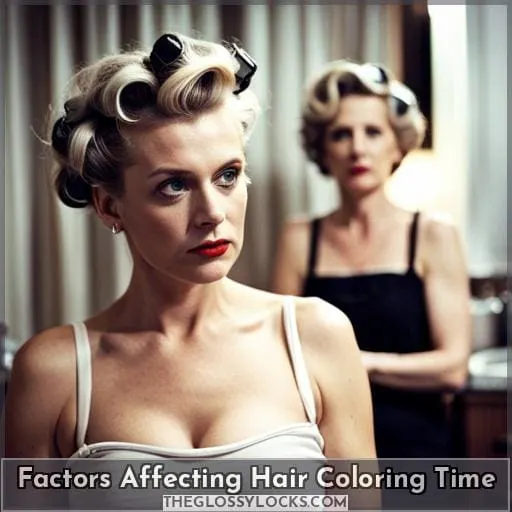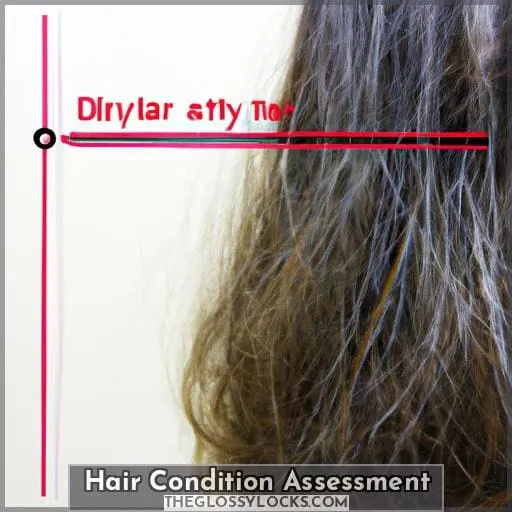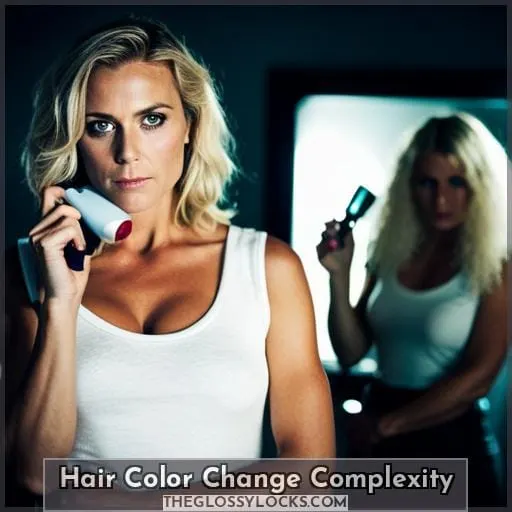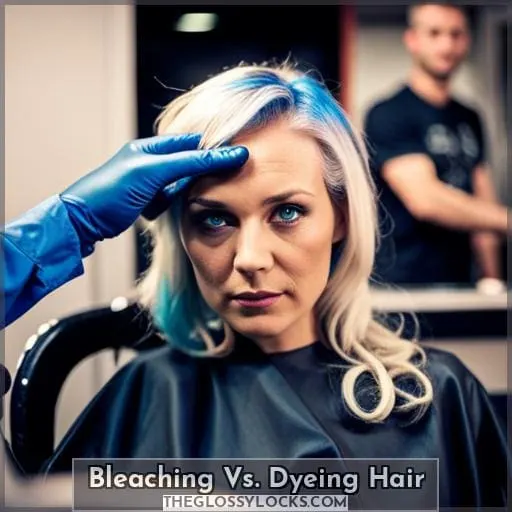This site is supported by our readers. We may earn a commission, at no cost to you, if you purchase through links.
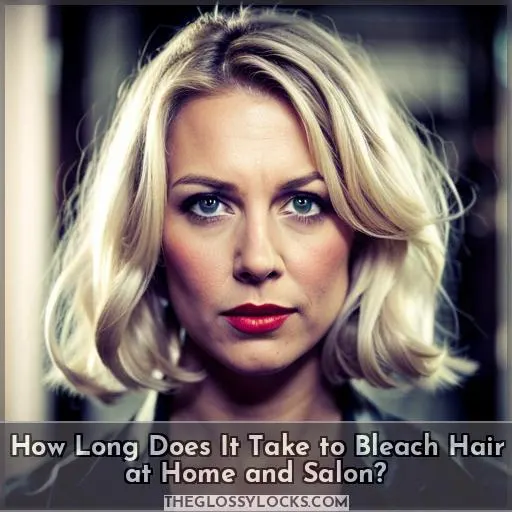 Looking to bleach your hair? Whether you’re considering doing it at home or going to a salon, you might be wondering how long the process will take. In this article, we’ll explore the factors that can affect hair coloring time and give you some tips on achieving your desired look.
Looking to bleach your hair? Whether you’re considering doing it at home or going to a salon, you might be wondering how long the process will take. In this article, we’ll explore the factors that can affect hair coloring time and give you some tips on achieving your desired look.
From assessing your hair’s condition to understanding the complexity of color changes, we’ve got all the information you need for a successful bleaching experience.
Table Of Contents
- Key Takeaways
- Factors Affecting Hair Coloring Time
- Hair Condition Assessment
- Hair Color Change Complexity
- Hair Texture and Density Impact
- Bleaching Vs. Dyeing Hair
- Recognize the Risks and Importance of Research
- Understanding the Timeline and Hair Levels
- Supplies You’ll Need for Bleaching
- Frequently Asked Questions (FAQs)
- Can I bleach my hair at home if it’s already been chemically treated or relaxed?
- How often should I bleach my hair to maintain the silver color?
- Is it possible to achieve silver hair without bleaching?
- What should I do if my hair becomes too damaged from bleaching?
- Can I use regular shampoo and conditioner after bleaching, or do I need specialized products?
- Conclusion
Key Takeaways
- Dark hair requires more time and multiple bleach sessions for significant lightening.
- Professional salons have expertise in achieving specific looks efficiently.
- Hair texture and density impact coloring time.
- Avoid bleaching at home for potential damage.
Factors Affecting Hair Coloring Time
When bleaching your hair, the time it takes depends on several factors.
Firstly, the desired look plays a role in determining how long you need to leave bleach on your hair.
Secondly, your current hair color will affect the amount of time needed for lightening.
Additionally, factors such as hair density and condition can impact coloring time.
Lastly, the application technique used also contributes to overall timing.
Desired Look
If you’re considering bleaching your hair at home or going to a salon, the time it takes to achieve your desired look is influenced by various factors:
- Current Hair Color: Darker hair requires more time and multiple bleach sessions for significant lightening.
- Hair Texture: Coarser hair may need additional processing time compared to fine hair.
- Bleaching vs Salon: Professional salons have expertise in achieving specific looks efficiently.
[…remainder of article…]
Current Hair Color
When considering how long it takes to bleach hair at home and salon, the current hair color plays a significant role in determining the duration.
Darker hair colors require more time for bleaching compared to lighter shades. The process of lightening involves breaking down pigments in the hair, and this can take longer for darker hues.
Additionally, maintaining consistent color transition from dark to light may require frequent touch-ups or root bleaching sessions at both home and salon settings.
Hair Density and Condition
Now, let’s delve into the impact of hair density and condition on the time it takes to bleach your hair at home or in a salon.
- Assess your natural hair texture (fine, medium, coarse).
- Determine your hair density (thin or thick).
- Understand that coarser hair may need more time for bleaching.
- Balance conditioner use based on your specific hair type to maintain moisture balance.
Consider these factors when determining how long it will take to bleach your unique strands and achieve the desired color change while keeping your overall hair health in mind throughout the bleaching process.
Application Technique
To achieve optimal results when bleaching your hair, it’s important to apply the bleach evenly and carefully.
Factors such as application technique, hair texture, and desired color change can affect the time needed for the process.
| Application Technique | Bleach Timing |
|---|---|
| Even and careful | Shorter |
| Uneven or rushed | Longer |
Applying bleach properly ensures even coverage and reduces the risk of uneven or patchy results.
Take your time to achieve beautiful, salon-worthy hair color at home while minimizing any potential risks associated with DIY bleaching techniques.
Hair Condition Assessment
To properly assess the condition of your hair before bleaching, start by:
- Checking for dry ends and any existing damage.
- Considering any previous hair coloring treatments you may have had, as this can impact the bleach process.
- Evaluating your hair’s overall health and moisture level to determine its ability to withstand the bleaching chemicals.
- Examining your strands for split ends and assessing the extent of any existing damage present in order to make an informed decision about whether or not it’s safe to proceed with bleaching.
Check for Dry Ends and Damage
Assessing the condition of your hair is crucial before bleaching, and one important aspect to consider is checking for dry ends and damage.
Bleaching can cause hair damage, so it’s essential to evaluate the health of your hair beforehand. Dry ends indicate moisture loss, while visible damage may include split ends or breakage.
If you notice any signs of dryness or damage, it’s best to address them before proceeding with bleach application to minimize potential harm.
Consider Previous Hair Coloring
When assessing your hair condition for bleaching, consider any previous hair coloring. This is important because previous color treatments can impact the overall outcome of the bleaching process.
Here are four factors to consider when evaluating your hair’s condition:
- Color correction needs based on past coloring
- Potential bleach allergies from prior chemical exposure
- Balancing moisture levels in previously treated hair
- Safe toning options considering previous color treatments
Evaluate Hair’s Health and Moisture Level
Check the health and moisture level of your hair to determine its condition before bleaching.
Evaluating your hair’s health is crucial in minimizing the risks associated with bleaching. Dry and damaged hair may require deep conditioning treatments or bond repairing treatments prior to bleaching.
Assessing the moisture level helps ensure that your hair can withstand the processing during bleaching without excessive damage or breakage.
Professional expertise can also provide valuable insights into achieving desired color transition while maintaining overall hair tone.
Examine Split Ends
Do you notice any split ends in your hair? Split ends are a common sign of hair damage and can affect the overall health of your hair.
When assessing the condition of your hair, it’s important to examine for split ends as they indicate that the cuticle layer has been compromised.
To maintain healthy hair, incorporate regular trims, deep conditioning treatments with a nourishing conditioner or mask, and follow proper post-bleaching care to prevent further damage.
Determine Existing Damage
To accurately assess the existing damage to your hair, start by:
- Examining for dry ends and any signs of breakage or split ends.
- Considering previous hair coloring.
- Evaluating the health and moisture level of your hair.
This will help determine the extent of any existing damage before proceeding with bleaching.
Assessing damage is crucial in determining how long it may take to bleach your hair at home or salon and selecting appropriate products for a successful outcome.
Hair Color Change Complexity
When it comes to hair color change complexity, it’s important to consider the nature of dark hair.
Dark hair typically requires bleaching for significant lightening, which can be a challenging process.
For drastic color changes, consulting a professional is recommended due to their expertise and ability to minimize damage.
While DIY options are available for those who prefer home bleaching, starting with a color close to your natural shade and being aware of the potential risks involved in bleaching are crucial considerations.
Dark Hair Requires Bleaching for Significant Lightening
If you have dark hair and are looking to achieve significant lightening, bleaching will be necessary. Dark hair requires the use of bleach in order to lighten it enough for noticeable color changes. This process can be complex and should ideally be done with professional consultation to prevent damage.
Transition phases may involve different shades of brassy hair before reaching the desired result. Aftercare suggestions include using sulfate-free products, air drying your hair, and incorporating supplies for toning such as silver toners into your routine.
| Transition Phases | Silver Hair Maintenance | Bleach Application |
|---|---|---|
| Different shades of | Use purple shampoo | Quality bleach product |
| brassy hair | Deep condition regularly (e.g., Briogeo Don’t Despair) |
Consult a Professional for Drastic Color Changes
For drastic color changes, it’s advisable to consult a professional who can provide expert guidance and minimize the potential damage (hair color change complexity).
Here are four reasons why seeking professional expertise for safe bleaching and hair color changes is crucial:
- Knowledge: Professionals have in-depth knowledge of different hair colors and textures, allowing them to recommend the best approach for your desired result.
- Experience: They’ve hands-on experience with various coloring techniques, ensuring even coverage and avoiding blotchy spots.
- Damage Prevention: Professionals use high-quality products that help minimize damage during the bleaching process.
- Desired Results: With their expertise, professionals can achieve your desired hair color while maintaining its health.
Consulting a professional ensures safer bleaching practices and increases the likelihood of achieving desirable results when making drastic hair color changes at home or in a salon setting.
Avoid Bleaching at Home for Potential Damage
Transitioning to a lighter hair color can be a complex process, and it’s important to consider the potential risks involved in bleaching at home.
Bleaching carries certain risks such as damage to your hair texture and overall health.
While there are benefits to bleaching at home like cost-effectiveness and convenience, the lack of professional expertise increases the likelihood of undesirable results and potential damage.
Start With a Color Close to Natural Shade for DIY
To achieve the best results when bleaching your hair at home, start with a color that closely matches your natural shade. This step is crucial to minimize damage and ensure a smooth transition in color.
Starting with a similar shade helps to reduce the risks associated with bleaching, such as hair breakage and dryness.
Consider Risk of Damage During Bleaching
When bleaching your hair, it’s important to consider the risk of damage that can occur during the process.
Choosing toning products and using proper bleaching techniques are crucial for minimizing potential damage.
It’s also essential to understand how to maintain your hair color after bleaching, whether you choose salon or home methods.
By being aware of common bleaching mistakes and taking necessary precautions, you can achieve your desired hair color without compromising its health and integrity.
Hair Texture and Density Impact
When bleaching your hair, it’s important to consider your natural hair texture and density.
Assess whether your hair is fine, medium, or coarse in texture and determine if it’s thin or thick in density.
Coarser hair may require more time for the bleach to fully process, while fine hair needs caution to prevent limpness.
Also, be mindful of balancing conditioner use based on your specific hair type for optimal results during the bleaching process.
Assess Natural Hair Texture
As you assess your natural hair texture, take into consideration its thickness and density to determine the appropriate bleaching time.
Texture assessment involves evaluating whether your hair is fine, medium, or coarse. Additionally, consider the density of your hair – whether it’s thin or thick. These factors will impact how long it takes for the bleach to process effectively on your strands.
It’s important to evaluate these aspects before proceeding with any bleaching treatment to ensure optimal results and minimize potential damage.
Determine Hair Density
Assess your hair density to determine the impact of hair texture and thickness on the bleaching process.
- Conduct a thorough hair density assessment
- Differentiate between fine and coarse hair textures
- Take necessary bleaching precautions based on your hair density
- Prevent damage by understanding how your hair texture impacts the bleaching results
Understand Coarser Hair May Need More Time
If you have coarser hair, it’s important to understand that it may require more time during the bleaching process.
Coarser hair has a denser texture and can be more resistant to bleach penetration. This means that the bleach may need additional time to lighten your hair effectively.
It’s crucial to find the right balance between achieving your desired color and maintaining moisture balance in your coarser hair.
Take caution not to leave bleach on for too long as this can lead to damage or overprocessing of fine strands.
Balance Conditioner Use Based on Hair Type
To effectively balance the use of conditioner based on your hair type, consider the texture and density of your hair.
Hair type plays a significant role in determining how often you should condition and what kind of products to use.
The impact of texture on conditioning is crucial as fine hair requires caution to prevent limpness while coarser hair may need more time for moisture absorption.
Understanding your specific needs will help maintain moisture balance during the bleaching process.
To effectively balance the use of conditioner based on your hair type, consider the texture and density of your hair. Conditioning plays a vital role in maintaining healthy, hydrated strands during and after undergoing bleaching processes.
- Fine Hair: Fine-textured locks require cautious conditioning to avoid weighing down or making them appear flat.
- Coarse Hair: Coarser textures generally benefit from longer periods with conditioner to ensure proper moisturization.
- Density Impact: Thicker or denser manes might necessitate extra attention when distributing conditioners evenly for optimal hydration.
Understanding these factors allows you to strike an ideal moisture balance tailored specifically for your unique journey through bleach treatments at home or salon settings
Caution for Fine Hair to Prevent Limpness
To prevent your fine hair from becoming limp during the bleaching process, exercise caution and take certain measures.
Fine hair is more prone to damage and may lose its strength when exposed to bleach.
Use a lower volume peroxide developer, such as 20 or even 10 volumes, to minimize potential harm.
Limit the duration of bleach application on fine hair and consider using strengthening treatments before and after bleaching for optimal care.
Bleaching Vs. Dyeing Hair
When considering bleaching versus dyeing hair, it’s important to understand the key differences between the two processes.
Bleaching involves removing natural or previous color from the hair using an aggressive chemical that opens up the cuticles and dissolves melanin.
On the other hand, coloring simply adds pigment to achieve a desired shade without lightening or stripping away existing color.
To ensure safe bleaching and minimize damage, it’s recommended to consult a professional who’s expertise in achieving drastic hair color changes.
Differentiate Between Bleaching and Coloring
When differentiating between bleaching and coloring hair, it’s important to understand the distinct processes involved.
Bleaching involves removing natural or previous color from the hair through an oxidation process.
On the other hand, coloring refers to adding pigment or dye to alter the hue of the hair while maintaining its natural base color.
Both professional salon services and DIY methods are available for both bleaching and coloring processes, each with their own advantages and considerations based on factors such as desired results, skill level, cost-effectiveness, and potential damage.
Understand Oxidation Process in Bleaching
Understand the oxidation process in bleaching to distinguish it from dyeing hair.
Bleaching involves a chemical reaction that lightens the natural color of your hair.
The oxidation process in bleaching breaks down melanin, which is responsible for hair color.
This can result in significant lightening, but it also poses a risk of hair damage if not done properly.
It’s important to consult with a professional and learn about toning techniques to minimize damage and achieve desired results safely.
Consult a Professional for Safe Bleaching
If you’re considering bleaching your hair, it’s important to consult a professional for safe and effective results.
They can provide expert advice on the best techniques and products to use, as well as assess the condition of your hair to minimize damage.
Professional consultation also helps in understanding the risks involved in bleaching and how to prevent hair damage.
Don’t take any chances with your precious locks; trust a professional for safe bleaching tips and effective hair bleaching methods.
Recognize the Risks and Importance of Research
Before embarking on the process of bleaching your hair at home or going to a salon, it’s important to recognize the risks involved and understand the importance of thorough research.
Bleach is a potent chemical that can weaken and break apart proteins in your hair if used incorrectly, leading to damage such as frizz and dryness.
It’s crucial to gather information from reliable sources, both online platforms like Pinterest or YouTube tutorials and professional colorists who’ve expertise in minimizing bleach damage.
Mastering the nuances of bleaching and toning requires continuous learning, so take the time to educate yourself before making any decisions about changing your hair color.
Bleach Weakens and Breaks Apart Proteins
To fully grasp the risks and importance of research when it comes to bleaching hair, you must recognize that bleach weakens and breaks apart proteins.
Understanding these risks emphasizes the importance of thorough research before attempting any bleaching process. It’s crucial to gather information on proper techniques, products, and aftercare methods to minimize potential damage during the hair color transition.
Extensive Research Needed for At-Home Bleaching
Before attempting to bleach your hair at home, it’s crucial that you conduct thorough research and educate yourself on the risks involved.
Recognize the importance of research in ensuring a successful at-home bleaching experience.
Consider factors such as:
- Timeline and patience
- Required supplies for bleaching
- Conducting a hair health assessment before proceeding with the process
- Understanding the differences between professional salon services and DIY methods
Extensive research will empower you to make informed decisions about bleaching your hair at home.
Online Sources and Professional Colorists Provide Information
Researching online and consulting with professional colorists are essential steps in recognizing the risks and understanding the importance of bleaching hair at home or salon.
Online sources, such as Pinterest, Reddit, and YouTube, provide valuable information on bleaching techniques and toning tips.
Professional colorists have in-depth knowledge and expertise to offer professional advice on how to bleach hair safely without compromising its health.
It’s crucial to gather information from reliable sources before attempting any DIY hair coloring process or seeking salon services for optimal results.
Bleaching and Toning Require Mastery of Nuances
Mastering the nuances of bleaching and toning hair requires understanding the risks involved and conducting thorough research.
To navigate through the challenges of bleaching, it’s important to develop a mastery of these nuances.
Whether you’re aiming for silver hair or any other color transformation, learning at home comes with its own set of considerations.
Recognize that professional expertise can provide valuable guidance in achieving desired results while minimizing potential damage during this process.
Continuous Learning Crucial for Understanding Hair Coloring
To truly understand the intricacies and potential risks involved in hair coloring, it’s crucial for you to continuously learn and stay informed about the ever-evolving world of hair color.
Continuous learning ensures your safety when using bleach, mastery of color application techniques, seamless transitions during hair transformations, and understanding product supplies needed for successful results.
Stay updated on new research and developments to enhance your knowledge in achieving beautiful hair colors while minimizing damage.
Understanding the Timeline and Hair Levels
Now, let’s delve into understanding the timeline and hair levels when it comes to bleaching.
Transitioning from dark hair to silver takes time, typically ranging from weeks to months. It’s important to allow your hair recovery time between bleach sessions and be patient throughout the at-home bleaching process.
During this transition, you may experience different shades of brassy hair before achieving a very light level 9 on the color scale necessary for silver hair.
Transitioning to Silver Takes Weeks to Months
Transitioning to silver hair takes time, patience, and careful consideration of the timeline and hair levels.
To understand the process better:
- Transitioning requires weeks to months for a drastic change.
- Hair needs recovery time between bleach sessions.
- Achieving silver hair involves reaching at least a very light level 9 on the color scale.
During this transition period, it’s important to:
- Follow proper bleaching progress
- Maintain silver hair with regular maintenance routines such as using toners and deep conditioning treatments both at home or in a salon setting
- Consider your specific transitioning tips based on your unique hair texture care needs
Hair Needs Recovery Time Between Bleach Sessions
Give your hair the necessary time to recover between bleach sessions.
Bleaching can be damaging to your hair, so it’s important to allow for proper recovery. The timeline for bleaching varies depending on factors such as the condition of your hair and desired results. It may take weeks or even months to transition from dark hair to silver. During this process, it’s crucial to prioritize the health of your hair by using appropriate at-home supplies and following a bleach timeline that allows for recovery between sessions.
| Factors Affecting Recovery | Time Needed |
|---|---|
| Hair Health | 4-6 weeks |
| Previous Damage | Varies |
| Hair Texture | Varies |
Patience is Vital in At-Home Bleaching Process
During the at-home bleaching process, it’s important to have patience and understand the timeline and levels of your hair.
- Transition phases: Your hair will go through different shades of brassy before achieving silver.
- Hair timeline: Transitioning to silver takes weeks to months, with recovery time between bleach sessions.
- Silver achievement: To achieve silver hair, you need to reach a very light level 9 on the color scale.
- At-home research: Extensive research is crucial for successful at-home bleaching results.
Transition Phases May Involve Different Shades of Brassy Hair
You may experience various shades of brassy hair during the transition phases when bleaching at home or in a salon.
Understanding the timeline and hair levels is crucial in achieving silver hair. Transitioning to silver takes weeks to months, and different shades of brassiness may appear along the way.
To combat brassy tones, consider using toners or purple shampoos for color correction. Additionally, incorporating deep conditioning treatments can help nourish and restore damaged hair during this process.
Achieving Silver Hair Requires Very Light Level 9 on Color Scale
To achieve silver hair, you’ll need to lighten your hair to a very light level 9 on the color scale. This requires intense bleach intensity and can pose challenges when done at home.
Recovering the hair’s health after bleaching is crucial for successful silver toning.
While salon professionals offer benefits like expertise and after-color treatments, at-home bleaching provides convenience and cost-effectiveness.
Consider these factors before embarking on your journey towards stunning silver locks.
Supplies You’ll Need for Bleaching
When it comes to bleaching your hair at home or in a salon, there are a few essential supplies you’ll need.
First and foremost, you’ll need a quality bleach product that’s suitable for your hair type and desired results.
Additionally, an appropriate peroxide developer is necessary to activate the bleach and lighten the hair.
Other supplies include:
- A plastic mixing bowl for preparing the mixture.
- An applicator brush for precise application.
- Gloves to protect your hands from chemicals.
- Hair sectioning clips to ensure even coverage throughout the process.
Quality Bleach Product and Peroxide Developer
To bleach your hair at home or in a salon, you’ll need to gather the necessary supplies, including a quality bleach product and peroxide developer.
Choosing a high-quality bleach is crucial for achieving effective results while minimizing damage to your hair.
The peroxide developer helps activate the bleaching process and determines how light your hair can become.
It’s important to follow professional guidance when selecting these products to ensure proper hair protection, color durability, and successful DIY bleaching without unnecessary challenges.
Plastic Mixing Bowl, Applicator Brush, and Gloves
To properly prepare for the bleaching process, gather your supplies including a plastic mixing bowl, applicator brush, and gloves.
- Plastic Mixing Bowl: Use a non-metallic bowl to mix the bleach and developer. This ensures that the chemicals won’t react negatively with metal.
- Applicator Brush: An applicator brush allows for precise application of bleach onto hair strands, ensuring even coverage and minimizing damage.
- Gloves: Protect your hands from chemical exposure by wearing gloves throughout the bleaching process.
Hair Sectioning Clips for Even Application
You’ll need hair sectioning clips for even application when bleaching your hair at home or in a salon.
These clips are essential for dividing your hair into manageable sections, ensuring that the bleach is applied evenly throughout.
By using sectioning clips, you can easily access each part of your head and achieve consistent results.
This technique allows for precise application and reduces the risk of missing any areas or causing uneven bleaching.
Make sure to secure each section with a clip before proceeding with the bleach application process.
Frequently Asked Questions (FAQs)
Can I bleach my hair at home if it’s already been chemically treated or relaxed?
Yes, you can bleach your hair at home even if it has been chemically treated or relaxed. However, be cautious as these processes may weaken the hair and increase the risk of damage.
How often should I bleach my hair to maintain the silver color?
To maintain the silver color in your hair, it’s recommended to bleach the roots every four to six weeks.
This allows for consistent touch-ups and helps maintain the desired shade.
Is it possible to achieve silver hair without bleaching?
Achieving silver hair without bleaching is challenging due to the need to lighten dark pigments. Bleaching lifts and removes these pigments, creating a blank canvas for silver tones.
What should I do if my hair becomes too damaged from bleaching?
If your hair becomes too damaged from bleaching, focus on repairing and nourishing it.
Use deep conditioning treatments, protein masks, and avoid further chemical processing until your hair is in better condition.
Consider seeking professional help for guidance and assistance.
Can I use regular shampoo and conditioner after bleaching, or do I need specialized products?
Regular shampoo and conditioner may not be sufficient after bleaching. Specialized products, like those designed for color-treated or damaged hair, can provide the necessary nourishment and protection to maintain healthy hair post-bleaching.
Conclusion
To achieve your desired hair color, it’s important to understand the factors that can affect the time it takes to bleach your hair at home or in a salon.
Factors such as your desired look, current hair color, hair density and condition, and application technique all play a role in the bleaching process.
Additionally, it’s crucial to assess your hair’s condition and understand the complexity of color changes.
By considering these factors and taking the necessary precautions, you can successfully bleach your hair and achieve your desired result.

